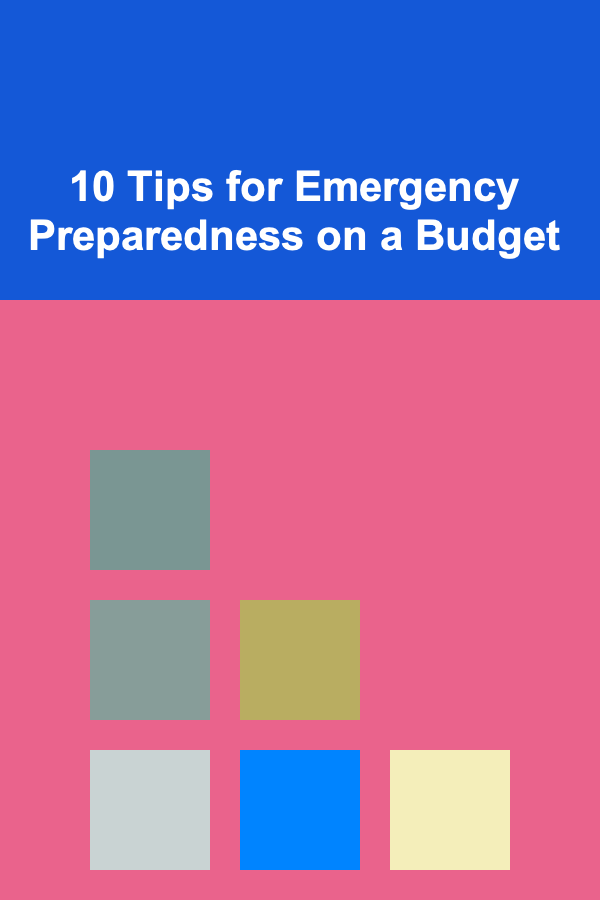
10 Tips for Emergency Preparedness on a Budget
ebook include PDF & Audio bundle (Micro Guide)
$12.99$5.99
Limited Time Offer! Order within the next:

Emergency preparedness is essential for everyone. Whether you're preparing for natural disasters, power outages, or any unexpected situations, being ready can save lives and reduce stress during critical times. However, many people assume that preparing for emergencies requires a significant financial investment. In reality, you can be well-prepared without breaking the bank. In this article, we'll explore ten tips for emergency preparedness on a budget, ensuring that you can protect yourself and your loved ones without overspending.
Create a Preparedness Plan
One of the most important---and cost-free---steps in emergency preparedness is creating a plan. This plan should outline how your family will respond to various emergency scenarios, whether it's a fire, earthquake, or severe weather. A good plan doesn't require spending money, but it can make all the difference when a disaster strikes.
Key Components of an Emergency Plan:
- Communication: Ensure everyone in the household knows how to reach each other if you're separated. Designate an out-of-area contact person that all family members can check in with.
- Evacuation Routes: Identify safe escape routes from your home or neighborhood. If possible, plan multiple routes.
- Meeting Points: Decide on a location where everyone will meet if you are unable to return home.
- Local Emergency Services: Know the contact details for emergency services in your area (police, fire department, hospitals).
By having a clear and organized emergency plan, you'll be prepared to act quickly when needed without the need for expensive equipment.
Stock Up on Non-Perishable Food
A well-stocked pantry is one of the most important aspects of emergency preparedness. When disaster strikes, you may not have access to stores for days, or even weeks. Having a supply of non-perishable food can ensure that you have the necessary sustenance to survive.
Budget-Friendly Tips for Stocking Up:
- Start Small: Begin with inexpensive, non-perishable items like canned vegetables, beans, rice, pasta, and grains. These items have long shelf lives and can be easily rotated into your regular meals.
- Look for Sales and Discounts: Watch for sales and bulk discounts at your local grocery store. Many stores offer significant discounts on non-perishable items, especially if you buy in bulk.
- Use Coupons: Take advantage of coupons or store loyalty programs to reduce costs. Some stores may also offer discounts on canned goods that are nearing their expiration date---these are still perfectly safe to consume for months after the printed date.
- Store What You Eat: To avoid food wastage, store the items you and your family actually eat regularly. When you rotate these items through your pantry, it ensures that you're ready for any emergency without accumulating unnecessary stock.
Building up a food supply doesn't have to be expensive. With careful planning and gradual purchasing, you can have a reliable food stash without straining your budget.
Buy Multi-Use Tools
When preparing for an emergency, it's wise to invest in multi-use tools that serve several functions. These items are often compact, durable, and can be used for a wide range of tasks in various emergency situations.
Essential Multi-Use Tools to Consider:
- Swiss Army Knife or Multi-tool: These can serve as everything from a knife to a bottle opener to a screwdriver, making them invaluable during emergencies.
- Fire Starter: A simple, inexpensive fire starter can help you build a fire for warmth, cooking, or signaling for help if necessary.
- Duct Tape: Duct tape is one of the most versatile tools you can own. It can be used to seal leaks, create makeshift bandages, repair items, and more.
- Solar-Powered or Hand-Crank Radio: A radio that doesn't rely on batteries is an essential tool to have for staying informed during power outages.
By investing in a few well-chosen multi-use tools, you can be prepared for a wide range of emergencies without spending a lot.
DIY First Aid Kits
Medical supplies are crucial during emergencies, but buying pre-packaged first aid kits can be expensive. You can create your own kit with basic supplies that will cover most common injuries or medical needs.
Essential Items for a DIY First Aid Kit:
- Adhesive Bandages: For minor cuts and scrapes.
- Antiseptic Wipes: To disinfect wounds.
- Pain Relievers: Include over-the-counter medications like ibuprofen or aspirin.
- Gauze Pads and Bandages: For larger wounds or to help stop bleeding.
- Scissors and Tweezers: For cutting bandages or removing splinters.
- Thermometer: For checking body temperature.
- Emergency Medical Manual: A guide for basic first aid procedures.
You can often find these items at dollar stores or buy them in bulk online, making it easy to assemble an affordable, comprehensive first aid kit. Additionally, consider storing extra supplies like allergy medications or any prescriptions you may need.
Use Your Car as an Emergency Supply Kit
Your car can be a valuable resource in an emergency, and it doesn't require you to spend much to convert it into a mobile emergency kit. Many people underestimate the potential of their vehicle, but it can serve as a shelter, a means of transportation, and a storage space for supplies.
Essential Items to Keep in Your Car:
- Jumper Cables: A must-have for car-related emergencies.
- Water and Snacks: A few bottles of water and non-perishable snacks (like granola bars or trail mix) can help sustain you if you're stranded.
- Blankets or Warm Clothing: Keep a couple of blankets or extra jackets in your car in case of cold weather emergencies.
- Portable Phone Charger: A car charger or a portable power bank can ensure that your phone stays charged, allowing you to call for help if needed.
- First Aid Supplies: A basic first aid kit should be kept in your car, especially if you spend a lot of time on the road.
By keeping essential emergency supplies in your car, you can be prepared for many situations, such as being stranded during a storm or facing a breakdown. Many of these items are inexpensive but invaluable in an emergency.
Build a Water Supply
Having access to clean drinking water during an emergency is crucial. Water can be one of the most expensive supplies to store, but with a little effort, you can ensure that your household has a reliable water supply.
Budget-Friendly Ways to Store Water:
- Reusable Containers: Instead of purchasing bottled water, invest in reusable water containers or large plastic barrels. These can be refilled as needed and stored for future use.
- Water Filtration Systems: If you can't store a large amount of water, consider purchasing a portable water filter or water purification tablets. These are relatively inexpensive and can allow you to purify water from natural sources in the event of an emergency.
- Repurpose Containers: You can repurpose old soda bottles, milk jugs, or other containers for water storage. Just make sure they are thoroughly cleaned before use.
- Rotate Stored Water: If you're storing water in plastic bottles or jugs, remember to rotate your supply every six months to ensure it remains safe to drink.
Water is essential for survival, and preparing it on a budget can be done by using reusable containers, purification methods, and simple storage strategies.
Secure Your Home Without Expensive Security Systems
In an emergency, securing your home can provide peace of mind. While expensive security systems are an option, there are budget-friendly ways to increase the safety of your home during a disaster or break-in situation.
Cost-Effective Home Security Tips:
- Reinforce Doors and Windows: Use deadbolts on doors and install window locks to prevent unauthorized entry. Simple upgrades like these can significantly increase security.
- DIY Home Alarms: Consider purchasing simple, budget-friendly motion detectors or door alarms that can alert you to movement or unwanted entry. These are affordable and effective for basic home protection.
- Emergency Lighting: Install battery-powered emergency lights in key areas, such as hallways, near exits, or in your yard. These can help guide you during a power outage or evacuation.
- Install Security Cameras: If possible, purchase a basic security camera system that you can monitor from your phone. There are affordable options available, and they can give you an extra layer of protection.
Home security doesn't have to be expensive. By making a few key upgrades to your doors, windows, and lighting, you can greatly increase your home's safety during an emergency.
Learn Basic Survival Skills
One of the most valuable things you can invest in is knowledge. Survival skills can often be the difference between life and death during an emergency, and learning them doesn't have to cost anything.
Basic Survival Skills to Learn:
- Fire Starting: Learn how to start a fire using different methods, such as matches, a flint, or even a magnifying glass.
- First Aid and CPR: Taking a basic first aid and CPR course can provide you with the knowledge to help yourself and others during medical emergencies.
- Basic Navigation: Learn how to use a compass and map, or how to navigate using natural landmarks in case GPS is unavailable.
- Food Foraging: Learn to identify local edible plants or ways to catch fish or small game, if needed.
These skills can be learned through free resources, such as online videos or local community groups, and they don't require a major financial investment.
Keep Extra Cash on Hand
In a true emergency, you may not have access to ATMs or banks, and credit cards may not work if the power is out. It's wise to keep a small stash of cash at home or in your emergency kit.
Budget-Friendly Tips for Managing Emergency Cash:
- Start Small: Set aside small amounts of cash in small denominations (such as $1, $5, or $10 bills). These can be useful for buying supplies from local vendors who may not accept cards during an emergency.
- Keep It Safe: Store your emergency cash in a waterproof container or safe location so it remains accessible when needed.
Having extra cash available during an emergency ensures that you're prepared for situations where electronic payments might not be an option.
Make Use of Community Resources
Finally, don't forget to take advantage of community resources when preparing for emergencies. Many local organizations provide free or low-cost emergency preparedness services, including training, supplies, and information.
Ways to Utilize Community Resources:
- Red Cross Training: The American Red Cross and similar organizations offer free or low-cost first aid, CPR, and disaster preparedness courses.
- Local Community Centers: Many community centers host emergency preparedness workshops or provide free emergency kits to residents.
- Public Libraries: Libraries often have free resources and workshops on emergency preparedness, survival skills, and how to handle various disaster scenarios.
Leveraging community resources can provide valuable knowledge and tools without the need to spend money.
Conclusion
Emergency preparedness is a crucial part of ensuring the safety of you and your loved ones during unexpected situations. While many assume that preparing for emergencies requires significant financial investment, it's entirely possible to be well-prepared on a budget. By following the ten tips outlined above---creating a preparedness plan, stocking up on non-perishable food, investing in multi-use tools, and more---you can ensure that you are ready for any emergency, regardless of your financial situation.
The key is to start small, prioritize essential supplies, and gradually build your preparedness over time. With a little planning and creativity, you can be prepared for emergencies without overspending.
Reading More From Our Other Websites
- [Home Budget Decorating 101] How to Inject Personality Into Your Space: Inexpensive Ways to Add Personality to Your Home
- [Personal Finance Management 101] How to Manage Your Mortgage as a First-Time Homeowner
- [Scrapbooking Tip 101] How to Use Vintage Tickets and Stubs as Creative Scrapbook Anchors
- [Organization Tip 101] How to Share and Organize Recipes with Family Online
- [Home Pet Care 101] How to Provide Pet-Approved Activities for Small Apartments
- [Home Space Saving 101] How to Downsize Smart: Practical Steps to Embrace Minimalist Living and Declutter Your Life
- [Digital Decluttering Tip 101] Best Ways to Consolidate Cloud‑Based Collaboration Docs into One Hub
- [Personal Care Tips 101] How to Choose the Right Hair Oil for Your Hair Type
- [Home Budget 101] How to Set a Budget for Outdoor Entertaining and Landscaping
- [Survival Kit 101] Best Survival Kits: Top Kits for Every Emergency Situation

How to Clean Your Bathroom Without Harsh Chemicals
Read More
How to Involve Kids in Organizing Your Yard Sale
Read More
How to Plan a Successful Home Party with Limited Time and Resources
Read More
How to Safely Introduce a New Pet into Your Home
Read More
Selecting the Best Pastry Cloth for Rolling Dough: A Comprehensive Guide
Read More
10 Tips for Streamlining Your Grocery Errands
Read MoreOther Products

How to Clean Your Bathroom Without Harsh Chemicals
Read More
How to Involve Kids in Organizing Your Yard Sale
Read More
How to Plan a Successful Home Party with Limited Time and Resources
Read More
How to Safely Introduce a New Pet into Your Home
Read More
Selecting the Best Pastry Cloth for Rolling Dough: A Comprehensive Guide
Read More